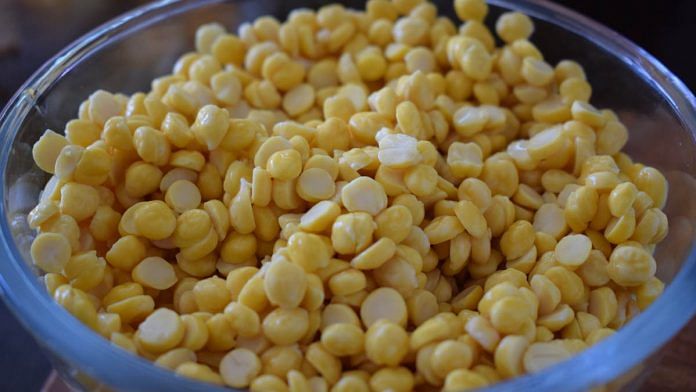New Delhi: The extension of the Pradhan Mantri Garib Kalyan Yojana (PMGKY) until 30 November has led to a huge requirement of chana dal. And to meet the new requirement, government agency NAFED has procured three times the quantity of chana dal compared to last year.
In the 2020-21 rabi season so far, NAFED has procured 21.43 lakh metric tonnes (LMT) of chana dal (as on 20 July), while the figure for last year (until 30 July) was 7 LMT.
According to officials in the Ministry of Food, Consumer Affairs and Public Distribution, unlike other rabi pulses such as moong and masoor, chana dal is still being procured in parts of Madhya Pradesh — Sehore and Raisen for example where there has been a bumper harvest. They expect the total procurement for this season to be closer to 30 LMT.
Also read: No dal fry — why states have to make do with chana under Modi govt’s new round of food aid
Chana dal under PMGKY
Under the PMGKY, every member of a ration card holding family is entitled to 5 kg free wheat/rice per month, while the family as a whole receives 1 kg free pulses every month, according to the announcement made by Finance Minister Nirmala Sitharaman in March. The scheme was to be valid for three months — April-June 2020.
However, in June, PM Modi announced the extension of the scheme until November, with only one difference — the only dal available under the scheme would be chana dal.
An official in the consumer affairs ministry told ThePrint on the condition of anonymity: “States begin to write to us from May end itself to extend the PMGKY scheme to provide food to poor people during Covid-19. However, though we had enough foodgrains with the FCI, the pulses buffer stock under NAFED was depleting as we just had 8.76 LMT of pulses in buffer stock on 25 June.”
Of this, the official said, 3.77 LMT was arhar dal, 1.14 LMT moong, 2.28 LMT urad, 1.30 LMT chana, and 0.27 LMT masoor.
“It was decided to proactively procure rabi pulses, moong, masoor and chana, but only chana is produced in large amounts in the country and procured at a low support price by the government.”
The official added: “PMGKY extension requires 12 LMT of chana dal for distribution, which would cost around Rs 6,849 crore to the government.”
Production and procurement of pulses
Chana dal accounts for 45-50 per cent of the total production of pulses in India — between the rabi and kharif seasons, its production is around 112.3 LMT per year, out of the overall figure of 230 LMT. Tur dal, with 42.5 LMT, accounts for 16 per cent. Together, these two pulses comprise up to three-fourths of India’s consumption.
In 2019, the chana dal production in the rabi season was estimated at around 90 LMT, but the government procured only 7 LMT. This year, the estimated production is around 100 LMT, while the procurement has more than tripled.
However, procurement of other rabi pulses by the government under the price support scheme for farmers has remained feeble compared to last year. For example, the production estimate for moong in 2019 was 67,000 metric tonnes (MT), of which the government procured 20,457 MT. But this year, while the estimate has gone up to 70,000 MT, the government procurement only 4,498 MT so far.
Chana dal is cheaper than most other alternatives for the government — its procurement rate is Rs 48.75 per kg. Arhar, in comparison, costs Rs 60/kg, whereas moong and masoor have a procurement price of Rs 71.96/kg and Rs 48/kg, respectively.
Also read: Onion prices could spike again in Sept-Dec as govt’s short of buffer stock procurement target




Government procured chana not chana daal.